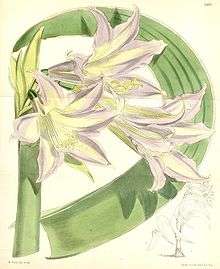Worsleya
| Worsleya procera | |
|---|---|
 | |
| Worsleya procera [1] | |
| Scientific classification | |
| Kingdom: | Plantae |
| Clade: | Angiosperms |
| Clade: | Monocots |
| Order: | Asparagales |
| Family: | Amaryllidaceae |
| Subfamily: | Amaryllidoideae |
| Genus: | Worsleya (W.Watson ex Traub) Traub |
| Species: | W. procera |
| Binomial name | |
| Worsleya procera (Lem.) Traub[2] | |
| Synonyms[3][4][5] | |
| |

Worsleya is a genus of Brazilian plants in the Amaryllis family, widely cultivated as an ornamental because of its showy flowers. There is only one known species, Worsleya procera, native to eastern Brazil.[6][7][8] It is one of the largest (around 1.5 meters high) and rarest members of the subfamily Amaryllidoideae (family Amaryllidaceae).
This species is also known as the empress of Brazil because of its origin in South America. It grows in very extreme and moist environments, and is commonly found near waterfalls in rich soil situated on granite rocks (which is why it is sometimes considered to be a lithophyte) and sunny places. However, it is very difficult to cultivate. It has plenty of needs, though it can exhibit great hardiness. It also has many ornamental traits.
The plant has a large bulb that produces a high stem with green recurved leaves. Worsleya produces spectacular and beautiful blooms. They are large, lilac to blue, with small freckles on them. The seeds are black and semicircular, and are usually sown in pumice or sometimes Sphagnum, although with Sphagnum the threat of decay is higher.[9][10][11]
References
- ↑ 1871 illustration from Hooker, Joseph Dalton. Curtis's Botanical Magazine, volume 97 Series 3, issue 27, plate 5883, as Amaryllis rayneri
- ↑ "Worsleya procera", World Checklist of Selected Plant Families, Royal Botanic Gardens, Kew, retrieved 2012-12-29
- ↑ The Plant List
- ↑ Kew World Checklist of Selected Plant Families
- ↑ Tropicos, Worsleya (W. Watson ex Traub) Traub
- ↑ Mabberley, David (May 3, 2002). "pbs New wiki photos Worsleya bloom". Retrieved 6 February 2011.
- ↑ Mabberley, David (1987). The plant-book. A portable dictionary of the higher plants. Cambridge University Press.
- ↑ Traub, Hamilton Paul 1944. Herbertia 10: 89
- ↑ Lemaire, (Antoine) Charles. 1864. L'illustration horticole 11: t. 408. as Hippeastrum procerum .
- ↑ Duchartre, Pierre Étienne Simon. 1863. Bulletin de la Société Botanique de France 10: 75. as Amaryllis procera nom illeg., not Salisbury 1796.
- ↑ Traub, Hamilton Paul & Moldenke, Harold Norman. 1949. Amaryllis Manual 23. as Worsleya rayneri